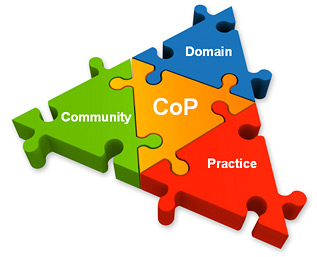Communities of Practice: a Toolkit
What Are Communities of Practice?

Coined by Drs. Jean Lave and Etienne Wenger-Trayner, Communities of Practice are groups of people who share a concern or a passion for something they do and learn how to do it better as they interact regularly. A Community of Practice (CoP) has three defining characteristics:
- Domain: CoP members share a commitment to the domain and a collective understanding of each other's competencies and basic understanding of their shared concern or passion.
- Community: CoP members engage in joint activities wherein they learn how to improve their similar programs, share best practices, and discuss areas of growth. These joint activities are foundational for building the "community" in a Community of Practice.
- Practice: CoP are practitioners; they develop a shared repertoire of resources: experiences, stories, tools, ways of addressing recurring problems—in short a shared practice.
Wenger-Trayner, E., & Wenger-Trayner, B. (n.d.). Introduction to Communities of Practice. Retrieved from http://wenger-trayner.com/introduction-to-communities-of-practice/.
Elements of CoP: Implementation Process
Communities of Practice are not stagnant. It is important that the plan for sustainability includes a strategy to:
- Recruit and sustain a diverse team of academic, clinical, professional, policy, and lay audiences.
- Conduct regular forums to identify, translate, and disseminate evidence based best practices.
- Identify best strategies and venues for reaching different populations.
- Evaluate effectiveness of strategies in reaching targeted audiences.
How to Create a CoP
While Communities of Practice share three defining characteristics, communities can shape and define themselves to serve the unique needs of their institution. From the case studies presented here by NCMEDR and CDHW, we found that CoPs are not standardized. In fact, CoPs work best when each institution has the opportunity to create and mold their community to their liking. With this toolkit, we present these steps as guidelines to create your own unique CoP.

STEP 1: Identify stakeholders and partners: Who might be appropriate members of your CoP?
STEP 2: Convene partners and establish CoP agreements such as purpose, common goals, expectations, and outcomes.
STEP 3: Solidify commitments to the CoP project and to CoP team members.
STEP 4: Develop pathways for CoP communication to build relationships and share personal narratives.
STEP 5: Determine initial project needs and opportunities.
STEP 6: Outline project outcomes: What do you need to learn, know, and clarify?
STEP 7: Identify useful tools to meet CoP goals such as evidence-based studies or systematic review.
STEP 8: Finalize project plan details: What are you going to do? What are your first steps? What foundation needs to be laid for long-term impact?
STEP 9: Plan next steps: What do you need to progress? How can we adequately sustain group efforts?
STEP 10: Identify strategies of Dissemination of Information for all audiences.
STEP 11: Evaluate plan and community agreements: What evaluation tools might be helpful?
STEP 12: Finalize concept with CoP members.
STEP 13: Implement plan.
STEP 14: Disseminate findings to academic medicine, clinical, and professional organization partners
STEP 15: Celebrate successes!
Tools and Resources
Links to Resources
For more information on the Center for a Diverse Healthcare Workforce's CoP Cohorts, please see below:
Cohort 1
- Collaborating to Strengthen Health Careers Pipelines at UC Davis
- Read our one-page summary here
Cohort 2
- Bridging Health Centers and Schools of Health


